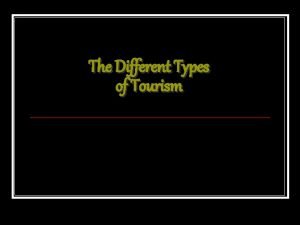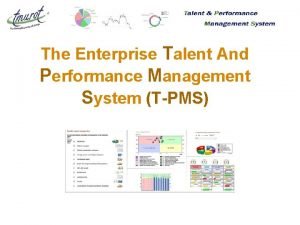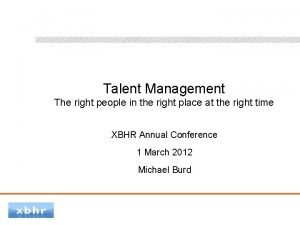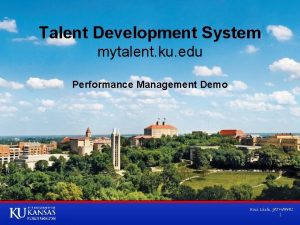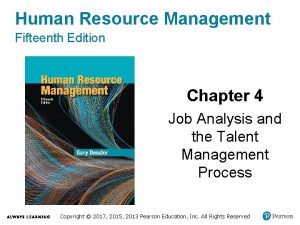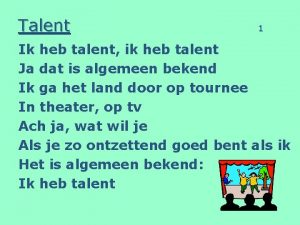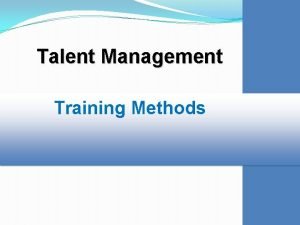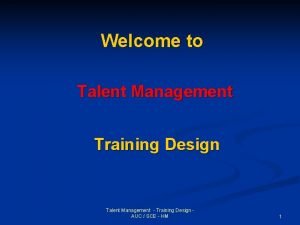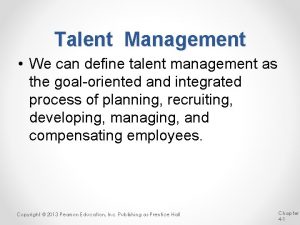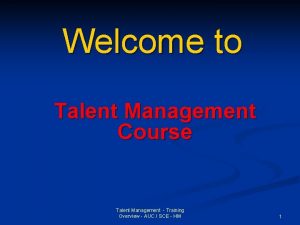Analytical insight into the talent management in tourism










- Slides: 10


Analytical insight into the talent management in tourism and hospitality in the Slovak business environment Michaela Sirkova (michaela. sirkova@unipo. sk) Viktória Ali Taha (viktoria. ali-taha@unipo. sk) University of Presov in Presov, Faculty of Management, St. 17. novembra 1, 080 01 Prešov, Slovak Republic

Introduction • Tourism is of great importance and one of the fastest growing sectors which has seen an enormous increase of international trade in services. • The paper deals with the talent management in the specific context of hospitality and tourism sector in Slovak organizations. It also highlights the benefits of talent management implementation in this sector and specify talent management processes used by tourism organizations in practice. • The paper draws primarily on a primary data survey of 87 respondents who were representatives of organizations working in tourism sector.

Talent management defines § has developed as a response to many changes in the workplace such as industrial revolution, the rise of labour unions, globalization or outsourcing (Frank & Taylor, 2004). § Nilsson and Ellström (2012, p. 27) point to the „shift from job security and lifelong employment to lifelong learning, employability, and talent management“. § by the Chartered Institute of Personnel and Development (CIPD) is defined as the “systematic attraction, identification, development, engagement, retention and deployment of those individuals who are of particular value to an organisation, either in view of their ‘high potential’ for the future or because they are fulfilling business/operation-critical roles” (CIPD, 2013). § this concept could also be defined as “the capability to create and continuously optimize the talent resources needed to execute a business strategy. § according Iles (2007, in D'Annunzio-Green, 2008) the talent management it is defined as a holistic approach to human resource planning aimed at strengthening organisational capability and driving business priorities using a range of HR interventions. § these include a focus on performance enhancement, career development and succession planning.

Analysis talent management in tourism and hospitality in the Slovak business environment § Primary data was collected via questionnaire survey among managers or representatives of 87 tourism and hospitality organizations in Slovakia. § Most of the surveyed organizations (71%) were medium-sized organizations (up to 100 employees), followed by small organizations (22%) and large organizations (7%). § In addition to the size another important criterion is the equity participation, while a sample involves 29% organizations with foreign capital/property participation. § Regarding the age structure which is one of the important demographic characteristics of employees working in the surveyed organizations: the most employees in tourism is aged 26 – 35 years (43%); the second largest age groups of employees in tourism are people at age 36 – 45 years (34%). Other age groups are not significantly represented in the workforce of surveyed organizations, while employees over 56 years represent only 2% of the workforce.

Results 1. The survey showed that only 36% of surveyed companies implement (to a greater or lesser extent) talent management; – the main reason for non-use of talent management is the “lack of human resources” (50% of organizations chose this option), it should be added that 72% of these organizations is aware of the need for talent management. 2. In terms of the length of talent management implementation, the majority (48%) of organizations implementing talent management uses this concept within the range of 2 – 3 years; – only 6% of organizations use talent management for more than six years. 3. Most organizations indicated that the talent development increased the employees' willingness to educate and improve their skills and also increased employee motivation; – another important “benefit” is the wages increase (55% of the organizations).

Results 4. We investigated what methods of talent development in the Slovak organizations dealing with tourism use. According to the results it is the most common method of talent development "taught courses" and "training". This marked the option agreement and strong agreement of 74% of organizations; – the most common answer was in the affirmative called "personal training". At the same time according to the chart it can be concluded that these organizations also focus on "communication" in the team and "teambuilding„, regarding the "IT and technology training” organization to label these options typically neutral, which means that these types of training are not for them to such an important type of training that would help them in the development of talent in the organization. 5. The research results showed that organizations most frequently retain and hire talented people for the position of “top/senior manager” (51% of the surveyed organizations indicate this answer) and “accommodation manager” (48% of organizations). It can be assumed that both abovementioned positions are crucial and therefore organizations devote considerable attention to filling these positions and employ talented candidates; – on the other side, the position “restaurant manager” is not likely to be seen as significant because majority of organizations do not need to hire talents for this position (as evidenced by the prevalence of discordant or neutral responses).

Discussion • (1) just over a third of surveyed organizations use talent management; • (2) organizations retain and hire talents mainly for the position “top/senior manager” and “accommodation manager”; • (3) most organizations implement (at least some of processes and tools of) talent management within the range of 2 – 3 years; • (4) talent development leads to employees' willingness to educate and increased motivation. The research findings support the hypotheses that the use of talent management tools and processes are affected by the size of organization but not affected by the (foreign) capital/property participation.

Conclusion §The tourism business success lies primarily in the quality, accessibility and variety of services provided, as well as on building relationships with customers. This requires skilled, dedicated and committed employees. Employers make every effort to attract, hire and recruit the right people. Despite the lack of jobs in tourism and masses of unemployed there is a talent insufficiency.

References § Ali Taha, V. , M. Sirková, M. & L. Bednárová. 2014. Talent management in Slovak organizations: insight into selected practices and processes. In: Intercathedra. No 30/2. Poznań (Poland): University of Life Sciences, Department of Economics and Wood Industry Management. ISSN 1640 -3622. § Baum, T. 2008. Implications of hospitality and tourism labour markets for talent management strategies. In: International Journal of Contemporary Hospitality Management, Vol. 20, No. 7. pp. 720 -729. ISSN 0959 -6119. § Bharwani, S. & N. Butt. 2012. Challenges for the global hospitality industry: an HR perspective. In: Worldwide Hospitality and Tourism Themes, Vol. 4, No. 2. pp. 150 -162. ISSN 1755 -4217. § Biswas, M. & D. Suar. 2013. Which Employees’ Values Matter Most in the Creation of Employer Branding? , In: Journal of Marketing Development and Competitiveness, Vol. 7, No 1. p. 93 -102. ISSN 2155 -2843. § Chartered Institute of Personnel and Development (CIPD). Talent management: an overview. updated in September 2013. Retrieved from: http: //www. cipd. co. uk/hr-resources/factsheets/talent-management-overview. aspx § D'Annunzio-Green, N. 2008. Managing the talent management pipeline: Towards a greater understanding of senior managers' perspectives in the hospitality and tourism sector. In: International Journal of Contemporary Hospitality Management, Vol. 20, No. 7. pp. 807 -819. ISSN 0959 -6119. § Frank, F. D. & C. R. Taylor. Talent management: trends that will shape the future, In: Human Resource Planning, Vol. 27, No. 1. pp. 33 -41. ISSN 0199 -8986. § Hsu, Y. 2015. The Review of Human Resource Strategies. Applying in Hospitality Industry in South California. In: International Business Research, Vol. 8, No. 3. pp. 133 -140. ISSN 1913 -9004 E-ISSN 1913 -9012. § Lewis, R. E. & R. J. Heckman. Talent management: a critical review. In: Human Resource. Management Review, Vol. 16, No. 2. pp. 139 -54. ISSN 1053 -4822. § Moroz, P. 2015. The implementation of talent management in tourism enterprise [Magister thesis]. University of Prešov in Prešov. Faculty of Management. § Nickson, D. 2007. Human resource management for the hospitality and tourism industries. Elsevier. ISBN 978 -0 -7506 -6572 -8 (0 -7506 -6572 -6). § Nilsson, S. & P. Ellström. 2012. Employability and talent management: challenges for HRD practices. In: European Journal of Training and Development, Vol. 36, No. 1. pp. 26 -45. ISSN 2046 -9012 § Ready, D. A. & J. A. Conger. 2007. Make Your Company a Talent Factory. In: Harvard Business Review. § Saar, S. S. 2013. The Challenge of Developing and Retaining Talent. In: Supply Chain Management Review, Vol. 17, Iss. 2. pp. 8 -9. ISSN 1521 -9747. § Serban, A. & M. Andanut. 2014. Talent Competitiveness and Competitiveness through Talent, In: Procedia Economics and Finance, Vol. 16. pp. 506 -511. ISSN 2212 -5671. § Sonnenberg, M. Talent – Key ingredients. Accenture Talent & Organization Performance, 2010. Retrieved from: http: //www. accenture. com/Site. Collection. Documents/Local_Netherlands/Talent%20% 20 Key%20 ingredients_Brochure_2011. pdf § United Nations International Trade Statistics Konwledgebase, 2011. Retrieved from: http: //unstats. un. org/unsd/tradekb/Knowledgebase/IRTS-2008 § UNWTO Tourism Highlights, 2015 Edition. Published: June 2015. e. ISBN: 978 -92 -844 -1689 -9. Retrieved from: http: //www. eunwto. org/doi/book/10. 18111/9789284416899 § World Travel and Tourism Council. Global Talent Trends and Issues for the Travel & Tourism Sector (final report). January 2015. Retrieved from: http: //www. wttc. org/-/media/382 bb 1 e 90 c 374262 bc 951226 a 6618201. ashx
 Mass tourism vs alternative tourism
Mass tourism vs alternative tourism Hp insight agent
Hp insight agent Enterprise talent management software
Enterprise talent management software Talent management wheel
Talent management wheel Integraal talent management
Integraal talent management Ku learning management system
Ku learning management system Talent management and succession planning toolkit
Talent management and succession planning toolkit Talent management sap
Talent management sap The pool talent management
The pool talent management Talent management scorecard
Talent management scorecard Chapter 4 job analysis and the talent management process
Chapter 4 job analysis and the talent management process
